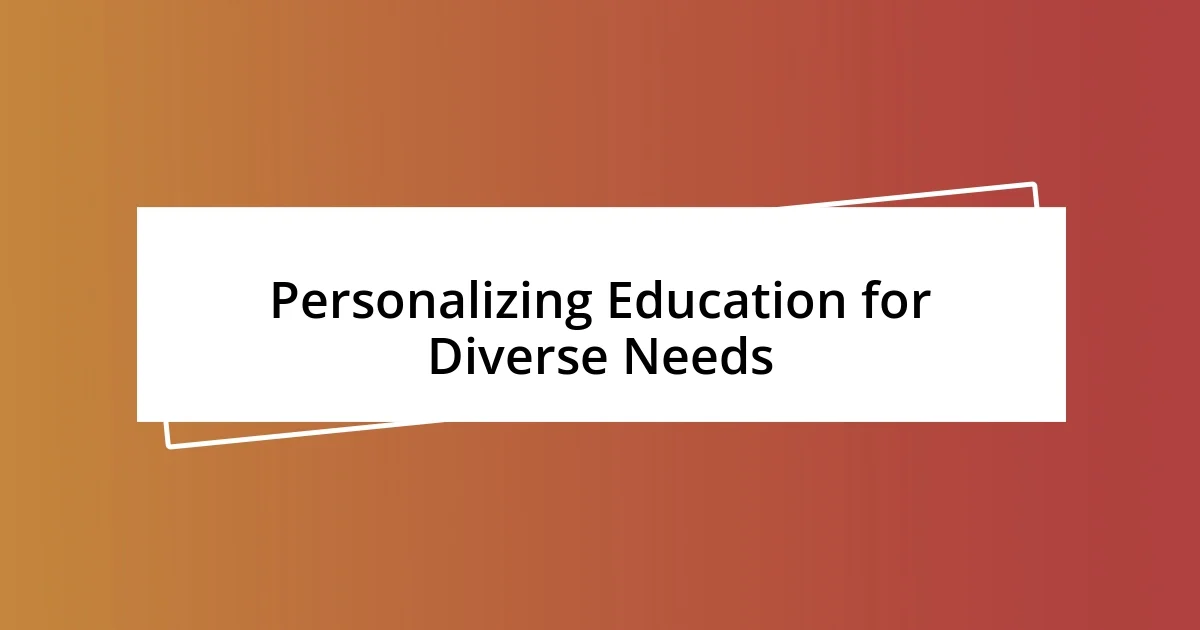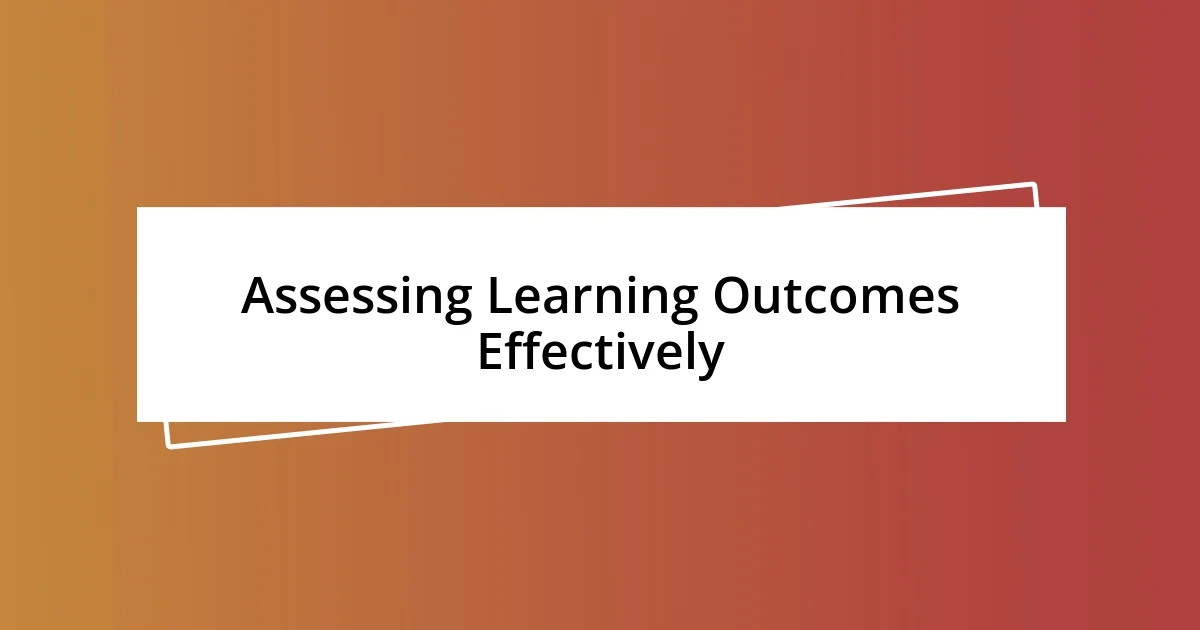Key takeaways:
- Effective health education emphasizes engagement, adaptability, and a supportive atmosphere to enhance learning outcomes.
- Utilizing technology, such as mobile apps and multimedia tools, can significantly improve accessibility and understanding of health topics.
- Personalizing education by addressing diverse backgrounds and offering various engagement methods fosters inclusivity and deeper connections among learners.

Understanding Health Education Basics
Health education is fundamentally about empowering individuals to make informed choices regarding their well-being. I remember attending a workshop years ago that explained the significance of understanding basic nutrition labels. It was a small moment, but it sparked my curiosity—it made me think: how often do we really know what we’re consuming? That workshop opened my eyes to the critical role that awareness plays in our health decisions.
The essence of health education lies in teaching skills to analyze health information critically. I often ponder how easily misinformation can spread, especially in today’s digital age. For instance, I once fell for a trendy diet promoted on social media. It wasn’t until I sought out reliable sources and educated myself on nutrition that I realized the importance of evidence-based information. Isn’t it fascinating how knowledge can truly transform our perspective on health?
Moreover, effective health education goes beyond simple presentations of facts; it includes understanding behaviors and motivations. I recall coaching a community group on stress management techniques, which taught me that creating trust and a safe environment is key. I could see the participants opening up and sharing personal stories—this connection made the learning experience so much richer. Have you ever felt that sense of belonging while learning? It’s powerful, and it can foster a community of support that enhances health outcomes.

Key Principles of Effective Education
The first principle of effective education is the importance of engagement. I once took part in a session where the instructor used role-playing to illustrate a health crisis scenario. It was not only informative but also fun to participate in; I felt invested in the outcome. Have you ever noticed how much more you learn when you’re actively involved? Engagement creates a deeper understanding and retention, which is crucial in health education.
Another key principle is adaptability. During one of my teaching experiences, I had to adjust my content on mental health awareness to meet the diverse needs of my audience. Some were more experienced, while others were encountering these topics for the first time. By tailoring my approach, I ensured that everyone found value in the session. This ability to pivot is essential. How do you think educational content could have a broader impact if it catered to different learning styles?
Lastly, fostering a supportive atmosphere cannot be overstated. In one workshop on physical activity, I remember the palpable sense of camaraderie among participants as we shared our fitness journeys. Creating a space where individuals feel comfortable can significantly alter their willingness to participate. Isn’t it amazing how a simple feeling of safety can encourage people to open up and learn more effectively?
| Key Principles | Description |
|---|---|
| Engagement | Active involvement enhances learning and retention. |
| Adaptability | Tailoring content to diverse audiences improves understandability. |
| Supportive Atmosphere | A safe and welcoming environment encourages openness and sharing. |

Strategies for Engaging Learning
When it comes to strategies for engaging learning, I find that interactive activities make a huge impact. In one workshop I led, we transformed a typical lecture into a lively discussion filled with small group debates. I could see the spark in participants’ eyes as they interacted and shared insights. It’s fascinating how conversation ignites enthusiasm and deepens understanding.
Here are a few engaging strategies to consider:
- Collaborative Projects: Encourage group work that allows participants to explore topics together.
- Gamification: Incorporate games or challenges related to health education to keep the experience enjoyable.
- Real-Life Scenarios: Use case studies and role-playing to allow learners to apply concepts in a real-world context.
Another effective approach is utilizing multimedia tools. I remember facilitating an online session where we watched a documentary on mental health before discussing it. The visuals and stories woven into the footage drew everyone in, sparking thoughtful dialogue. Each person’s perspective added a rich layer to our understanding. It’s incredible how the right mix of technology can enhance engagement in learning settings.
- Videos and Documentaries: Use short films to prompt discussion and critical thinking.
- Interactive Polls or Quizzes: Engage learners in real-time feedback to gauge understanding and opinions.
- Social Media Integration: Create groups or discussions on platforms where participants can share resources and experiences outside the traditional classroom setting.

Utilizing Technology in Health Education
Utilizing technology in health education has transformed how we connect with learners. I recall a time when I integrated a mobile app into a nutrition workshop. Participants used it to track their food intake in real time, which sparked conversations about healthy choices right there and then. Have you ever realized how immediate feedback can motivate someone to shift their habits? It’s like having a personal coach right in your pocket, encouraging you with every choice.
Another powerful aspect of technology in this field is the ability to reach wider audiences through online platforms. I once hosted a webinar aimed at raising awareness about chronic diseases. It was astounding to see participants logging in from different states, all invested in the discussion from the comfort of their homes. This accessibility not only fosters inclusivity but also broadens the diversity of perspectives shared. Doesn’t it make you think about how many more people we can empower through such mediums?
Finally, technology enables the use of engaging visual content that can simplify complex health topics. For instance, during a diabetes education session, I employed infographics to illustrate blood sugar levels and their fluctuations. The colorful visuals not only caught everyone’s attention but also made the information memorable. It’s intriguing to consider how a well-designed graphic can clarify what words sometimes fail to convey. Have you noticed how images and charts can often speak louder than text?

Personalizing Education for Diverse Needs
When it comes to personalizing education for diverse needs, I’ve learned that understanding each learner’s background is crucial. I remember teaching a group with varying levels of health literacy. One participant struggled with medical jargon, while another was already well-versed in the terminology. It was eye-opening to see how tailoring explanations and using everyday language helped bridge that gap, making the material accessible for everyone involved. Isn’t it fascinating how a simple shift in language can foster inclusivity?
Additionally, I’ve found that offering choices in how learners engage with content can significantly enhance their experience. For example, during a session on mental health, I let participants choose between breakout discussions, written reflections, or creating art to express their feelings. The variety not only accommodated different learning styles but also encouraged participants to connect deeply with the material in a way that resonated personally. Have you noticed that when people feel empowered to express themselves in their preferred manner, they become more invested in their journeys?
In my experience, ongoing feedback is another component that can’t be overstated. After implementing a mentorship program in my health classes, I observed remarkable transformations. One mentee shared how regular check-ins provided the motivation she needed to stay focused on her wellness goals. Those moments of connection became vital in guiding her experience. How often do we allow ourselves the space to reflect and receive support? The beauty of this approach is that it fosters a personalized learning environment where everyone feels seen and heard.

Assessing Learning Outcomes Effectively
To truly assess learning outcomes effectively, I’ve learned that blending traditional methods with innovative approaches can yield impressive results. For instance, after a health workshop, I used a quick survey to gauge participant knowledge before and after the session. It was rewarding to see statistical improvements, but what struck me more was the personal feedback shared in comments—like how one participant felt empowered to try new healthy recipes. Don’t you find it amazing how numbers and personal stories can paint a fuller picture together?
Moreover, I believe that engaging participants in self-assessment can deepen their understanding. During a recent series on physical activity, I encouraged learners to reflect on their progress weekly through journals. This not only fostered accountability but also cultivated a sense of ownership over their health journeys. Seeing one individual’s excitement to share their newfound love for morning walks reminded me of the transformative power of self-reflection. Have you ever experienced a moment where your personal insights led to a powerful realization?
Feedback is an essential aspect of effective assessment that often gets overlooked. I remember hosting a panel discussion on mental health where anonymous questions were collected. This method opened up channels for honesty and vulnerability that I hadn’t anticipated. One individual’s question regarding anxiety struck a chord in the room and led to a deeper, more meaningful conversation. It’s moments like these that highlight how creating a safe space for dialogue can unveil essential learning outcomes we might miss otherwise. How can we ensure that every voice is heard and valued in our educational spaces?














